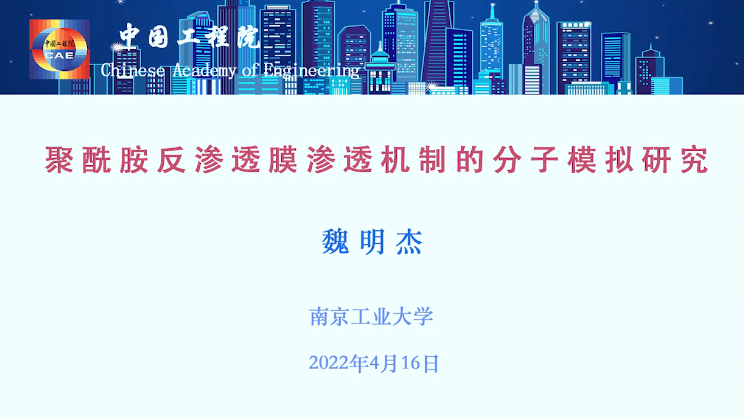检索范围:
排序: 展示方式:
《化学科学与工程前沿(英文)》 2022年 第16卷 第5期 页码 564-591 doi: 10.1007/s11705-021-2109-z
关键词: reverse osmosis polyamide thin film composite membranes chlorine resistance surface modification
《化学科学与工程前沿(英文)》 2023年 第17卷 第9期 页码 1183-1195 doi: 10.1007/s11705-022-2287-3
关键词: reverse osmosis nanocontainer self-healing chlorine resistance water permeability
《化学科学与工程前沿(英文)》 2023年 第17卷 第12期 页码 2074-2087 doi: 10.1007/s11705-023-2342-8
关键词: poly(lactic acid) foaming microfibrillation rheological property crystallization
芦瑛,赵海洋,张林,侯立安
《中国工程科学》 2014年 第16卷 第7期 页码 84-88
以间苯二胺(MPD)为水相单体、均苯三甲酰氯(TMC)为油相单体,氧化石墨烯(GO)作为水相添加物,采用界面聚合法,制备了GO-PA(聚酰胺)/PSF(聚砜)混合基质反渗透复合膜。采用扫描电子显微镜表征了膜形貌,考察了该膜对氯化钠的截留性能及耐氯性。结果表明,聚酰胺反渗透膜填充氧化石墨烯后,其分离性能优于聚酰胺膜,且具有较好的耐氯性。随着氧化石墨烯含量的增加,膜的通量增大,当添加量为0.005 %时,膜具有最大通量,为63 L/(m2·h)。
Preparation and rheological behaviors of PA6/SiO2 nanocompiste
WEI Shanshan, LIU Yuejun, LI Xianggang, HUANG Yugang, WANG Xiayu, ZHANG Ping
《化学科学与工程前沿(英文)》 2007年 第1卷 第4期 页码 332-337 doi: 10.1007/s11705-007-0060-2
关键词: polyamide temperature rheological activation pesudoplastic
1,5-戊二胺的细菌合成及应用 Review
马伟超, 陈可泉, 李艳, 郝宁, 王昕, 欧阳平凯
《工程(英文)》 2017年 第3卷 第3期 页码 308-317 doi: 10.1016/J.ENG.2017.03.012
1,5-戊二胺是一种广泛分布于原核和真核生物中的具有多种生物活性的天然多胺,正日益成为一种重要的工业化学品,并在多个领域展现出广泛的应用前景,特别是作为单体用于合成生物基聚酰胺。基于1,5-戊二胺的聚酰胺5X 具有优异的性能和环境友好特性,因而有广泛的应用前景。本文总结了近期关于1,5-戊二胺在细菌中的生物合成、代谢及生理学功能,着重介绍了1,5-戊二胺在大肠杆菌的代谢调控机制。文中还综述了微生物发酵法和全细胞催化法生产1,5-戊二胺的进展及1,5-戊二胺的分离纯化方法。此外,对1,5-戊二胺在生物基聚酰胺合成中的应用进行了总结,并对利用可再生资源生产1,5-戊二胺进行了展望和对以后的研究提出了建议。
聚酰胺反渗透膜中水传递阻力的分子模拟——界面阻力和内部阻力 Article
宋阳, 魏明杰, 徐放, 汪勇
《工程(英文)》 2020年 第6卷 第5期 页码 577-584 doi: 10.1016/j.eng.2020.03.008
在分子水平上理解水分子在聚酰胺(PA)反渗透(RO)膜中的传递阻力对于这些膜的设计、制备和应用具有非常重要的指导意义。本文通过分子模拟来计算总传递阻力,并将其分成两部分——内部阻力和界面阻力。内部阻力取决于PA层的厚度,而界面阻力则不然。基于5 nm 厚的PA层的模拟显示界面阻力对总阻力的贡献率很大(> 62%)。然而,现实世界中,对于具有200 nm PA层的RO膜,界面阻力起次要作用,其贡献率低于10%。这表明,当使用典型方法估算RO膜的传递阻力时,存在不准确的风险,因为该方法简单地将5 nm厚的PA层的总阻力进行倍增,使得界面阻力被错误放大。此外,界面阻力和内部阻力均取决于PA层的化学性质。我们的模拟显示,减少PA层中剩余羧基的数量会导致内部阻力降低,因此,可以在不牺牲离子截留的情况下改善水的渗透性,这与实验结果高度吻合。

标题 作者 时间 类型 操作
Surface-tailoring chlorine resistant materials and strategies for polyamide thin film composite reverse
期刊论文
Self-healing polyamide reverse osmosis membranes with temperature-responsive intelligent nanocontainers
期刊论文
glycol on the crystallization, rheology and foamability of poly(lactic acid) containing generated polyamide
期刊论文
Preparation and rheological behaviors of PA6/SiO2 nanocompiste
WEI Shanshan, LIU Yuejun, LI Xianggang, HUANG Yugang, WANG Xiayu, ZHANG Ping
期刊论文
魏明杰:聚酰胺反渗透膜渗透机制的分子模拟研究(2022年4月16日)
2022年06月09日
会议视频








